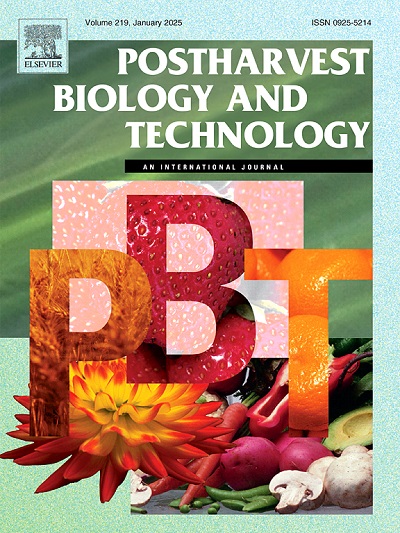The function of BoVDAC3 from broccoli in oxidative stress response and programmed cell death in BY-2 cells
IF 6.4
1区 农林科学
Q1 AGRONOMY
引用次数: 0
Abstract
Voltage dependent anion channel protein (VDAC) had been shown to played a critical role in programmed cell death (PCD). However, the functional role of BoVDAC3 in oxidative stress response and PCD process of postharvest broccoli remains unclear. In this study, BoVDAC3 was overexpressed in tobacco bright yellow-2 (BY-2) cells to investigate its function. The results showed that the cell morphology and nuclear integrity of transgenic BY-2 cells were severely disrupted after oxidative stress compared with wild-type (WT) cells. BoVDAC3 overexpressing dreadfully increased the content of reactive oxygen species (ROS) and malondialdehyde (MDA) in BY-2 cells, while simultaneously decreasing proline (Pro) synthesis and impairing the function of the AsA-GSH cycle, along with key antioxidant enzymes. Moreover, the expression levels of AsA-GSH cycle-related genes (NtGST, NtAO, NtAPX), Pro synthesis-related genes (NtP5CR, NtP5CS, Ntδ-OAT), antioxidant enzyme genes (NtSOD, NtPOD, NtCAT), and the anti-apoptotic gene (NtDAD1) were markedly reduced in the transgenic cells compared to the control group following H2O2 treatment. Conversely, the expression levels of apoptotic genes (NtSIPK, NtERF3) were considerably elevated under the same experimental conditions. Furthermore, treatment with 4,4′-diisothiocyanostilbene-2,2′-disulfonic acid (DIDS), a VDAC inhibitor, produced the opposite phenotype to BoVDAC3-overexpressing cells. These findings suggest that BoVDAC3 overexpression may accelerate ROS accumulation, thereby inducing PCD in BY-2 cells.
西兰花BoVDAC3在BY-2细胞氧化应激反应和程序性细胞死亡中的作用
电压依赖性阴离子通道蛋白(VDAC)在程序性细胞死亡(PCD)中起关键作用。然而,BoVDAC3在采后西兰花氧化应激反应和PCD过程中的功能作用尚不清楚。本研究通过在烟草亮黄-2 (BY-2)细胞中过表达BoVDAC3来研究其功能。结果表明,与野生型(WT)细胞相比,氧化应激后转基因BY-2细胞的细胞形态和细胞核完整性受到严重破坏。BoVDAC3过表达严重增加了BY-2细胞中活性氧(ROS)和丙二醛(MDA)的含量,同时降低了脯氨酸(Pro)的合成,损害了AsA-GSH循环的功能,以及关键的抗氧化酶。H2O2处理后,与对照组相比,转基因细胞中AsA-GSH周期相关基因(NtGST、NtAO、NtAPX)、Pro合成相关基因(NtP5CR、NtP5CS、Ntδ-OAT)、抗氧化酶基因(NtSOD、NtPOD、NtCAT)和抗凋亡基因(NtDAD1)的表达水平均显著降低。相反,在相同的实验条件下,凋亡基因(NtSIPK, NtERF3)的表达水平明显升高。此外,用VDAC抑制剂4,4 ' -二异硫氰酸二苯乙烯-2,2 ' -二磺酸(DIDS)处理,产生与bovdac3过表达细胞相反的表型。这些发现提示BoVDAC3过表达可能加速ROS积累,从而诱导BY-2细胞PCD。
本文章由计算机程序翻译,如有差异,请以英文原文为准。
求助全文
约1分钟内获得全文
求助全文
来源期刊

Postharvest Biology and Technology
农林科学-农艺学
CiteScore
12.00
自引率
11.40%
发文量
309
审稿时长
38 days
期刊介绍:
The journal is devoted exclusively to the publication of original papers, review articles and frontiers articles on biological and technological postharvest research. This includes the areas of postharvest storage, treatments and underpinning mechanisms, quality evaluation, packaging, handling and distribution of fresh horticultural crops including fruit, vegetables, flowers and nuts, but excluding grains, seeds and forages.
Papers reporting novel insights from fundamental and interdisciplinary research will be particularly encouraged. These disciplines include systems biology, bioinformatics, entomology, plant physiology, plant pathology, (bio)chemistry, engineering, modelling, and technologies for nondestructive testing.
Manuscripts on fresh food crops that will be further processed after postharvest storage, or on food processes beyond refrigeration, packaging and minimal processing will not be considered.
 求助内容:
求助内容: 应助结果提醒方式:
应助结果提醒方式:


